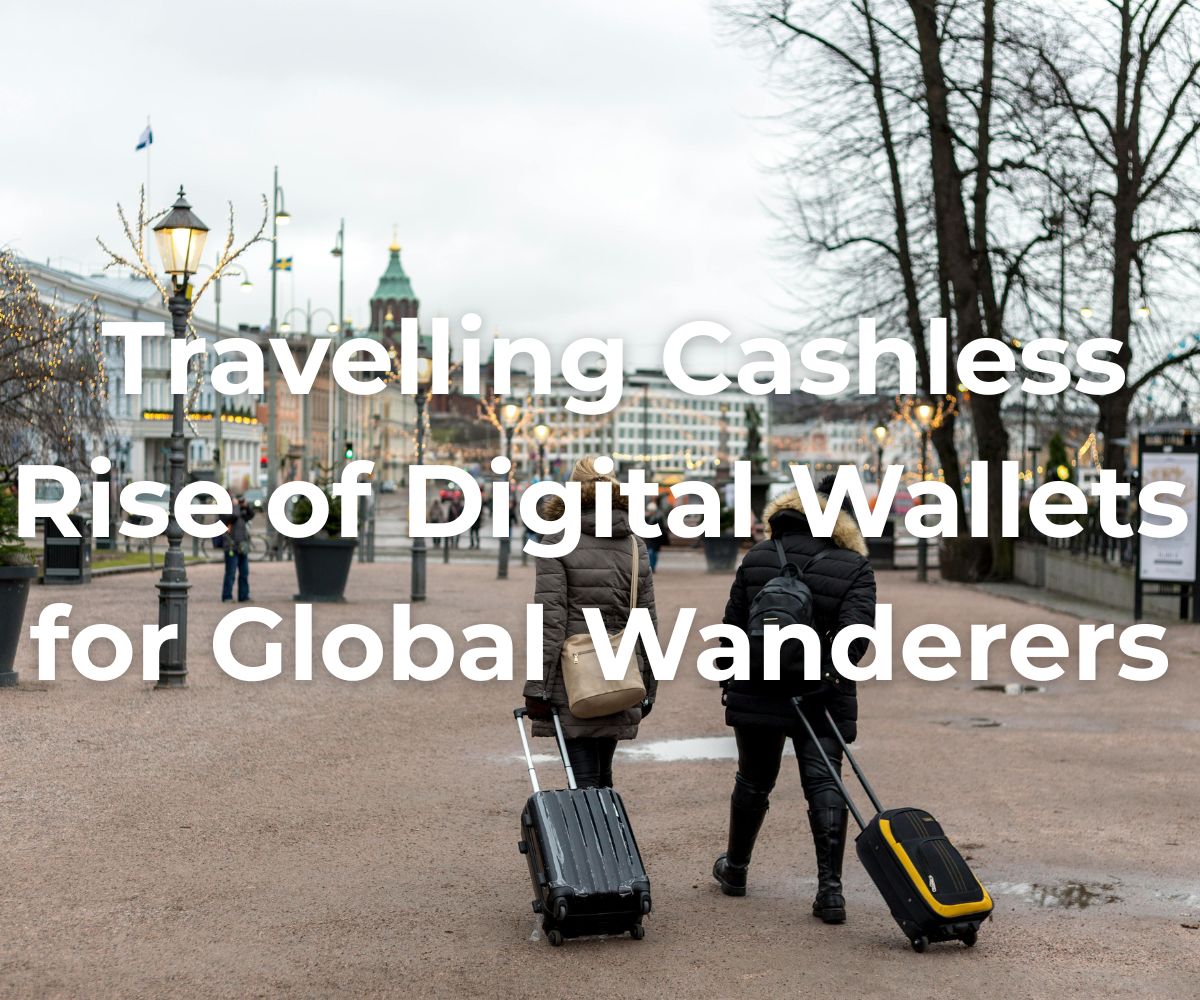traveling cashless rise of digital wallets for global wanderers
Description
Traveling Cashless: The Rise of Digital Wallets for Global Wanderers
Picture this: you're scrambling through currency exchange counters at the airport, juggling conversion rates in your head while sweating over fees. Sound familiar? Well, those headaches are becoming relics of the past. Today's savvy travelers have replaced fat wallets stuffed with foreign bills with something far more elegant, their smartphones.
Digital wallets are revolutionizing international travel by delivering instant currency conversion, rock-solid security, and ease that seemed impossible a decade ago. This blog walks you through mastering cashless travel, selecting platforms that actually work, and sidestepping expensive blunders that turn dream trips into financial nightmares.
The Digital Wallet Revolution in Travel Finance
Money management abroad has undergone a seismic shift recently. Mobile payments have evolved from novelty to necessity for globe-trotters who value efficiency.
Understanding this transformation matters because it directly impacts how much money stays in your pocket during international adventures. Let's examine the mechanics powering this payment revolution and how these systems operate seamlessly across international borders.
Here's something impressive: the global business travel sector pulled in roughly $933 billion, marking a 34% revenue jump in 2023, with projections showing continued expansion through 2024. These numbers underscore how both corporate travelers and leisure wanderers are wholeheartedly adopting digital payment methods.
Apple Pay now operates across 70+ countries, while Google Pay commands the Android marketplace worldwide. Regional nuances exist, though. Samsung Pay's distinctive MST technology interfaces with antiquated terminals that other wallets can't handle, and PayPal shines specifically for international money transfers.
Curious about how to get esim for uninterrupted connectivity during your travels? Modern explorers can now purchase eSIMs directly through numerous digital wallet platforms, enabling immediate payments while eliminating those frantic searches for physical SIM cards upon landing. This convergence demonstrates how payment innovation is blending with broader travel infrastructure.
Mobile Payments vs. Traditional Travel Money Methods
This comparison reveals where digital really dominates. Conventional credit cards slam you with 3% foreign transaction charges, whereas online payment solutions like Wise or Revolut levy under 1%. Physical cash forces you into dodgy exchange booths offering terrible rates, plus there's perpetual anxiety about pickpockets.
Digital wallets deliver immediate fraud safeguards; your phone's fingerprint or facial recognition outperforms any stolen wallet scenario. Live exchange rates show exactly what you're spending before finalizing transactions, unlike those nasty surprises from dynamic currency conversion at hotel checkouts.
Top Digital Wallets for Global Wanderers
Platform selection genuinely impacts your travel quality. Regional dominance varies dramatically, so smart travelers diversify their digital wallet portfolio.
Universal Digital Wallet Solutions
Apple Pay performs exceptionally throughout North America, Europe, and technologically advanced Asian markets. You'll require an iPhone 6 or later model, and configuration takes roughly 120 seconds. Google Pay blankets comparable geography but accommodates any NFC-capable Android device.
Samsung Pay's distinguishing trait? Compatibility with both NFC terminals and legacy magnetic stripe systems expands your payment flexibility considerably.
PayPal maintains supremacy for online reservations and cross-border transfers, though brick-and-mortar acceptance lags behind tap-based wallets. Each platform brings trade-offs. Apple Pay meshes elegantly with Apple's ecosystem, whereas Google Pay provides superior public transit integration in cities like London and Tokyo.
While universal options provide extensive coverage, experienced travelers recognize that certain destinations demand specialized platforms controlling their local markets; overlooking these regional powerhouses could leave you stranded without functioning payment methods.
Region-Specific Digital Payment Platforms
Headed to China? Alipay or WeChat Pay aren't optional; they're mandatory everywhere, from sidewalk noodle vendors to five-star establishments. India operates predominantly on Paytm and UPI, platforms that have transformed mobile payments throughout the Indian subcontinent. Southeast Asia belongs firmly to GrabPay, which evolved from ride-sharing into an everything-payment solution covering food delivery to utility bills.
Africa's M-Pesa dominates mobile financial services, particularly throughout Kenya, where it surpasses conventional banking penetration. Latin America favors MercadoPago, especially across Brazil, Argentina, and Mexico. Ignoring these regional champions proves costly; they frequently offer superior exchange rates and broader merchant acceptance than international alternatives within their territories.
Setting Up Your Travel-Ready Digital Wallet Ecosystem
Preparation distinguishes seamless journeys from stress-filled disasters. You'll need your digital wallets properly configured well before departure.
Once your digital payment ecosystem is fully optimized, you'll unlock strategic benefits that potentially save hundreds on each international excursion.
Pre-Departure Digital Wallet Preparation
Single-wallet reliance is rookie behavior. Configure a minimum of two different platforms. When your iPhone battery dies, having Google Pay on a backup Android saves your evening. Connect multiple credit and debit cards to each wallet for redundancy. Banks occasionally flag overseas transactions as fraudulent, so maintaining backup funding sources prevents getting financially stranded abroad.
Contact card issuers before traveling to authorize international activity. Numerous banks automatically block foreign purchases without advance notice. Preload local currencies into multi-currency wallets like Wise or Revolut before departure, and you'll secure better exchange rates versus waiting until arrival.
Two-factor authentication isn't negotiable. Activate biometric security (fingerprint or facial scanning) across every wallet. Configure real-time transaction notifications so suspicious activity gets flagged instantly.
Essential Mobile Payments Configuration
Most digital wallets support offline payment functionality, and your phone's NFC chip retains recent card information, enabling payments despite internet absence. This proves invaluable when you're underground in metro systems or exploring rural locations with unreliable coverage.
Numerous metropolitan areas allow direct transit card integration into your wallet. London's Oyster, Tokyo's Suica, and San Francisco's Clipper systems all integrate seamlessly. You'll bypass ticket kiosks entirely and tap directly through gates. Establish daily spending caps to minimize catastrophic losses if device security gets compromised.
Knowing where digital wallets function is valuable, but understanding how to defend against sophisticated threats targeting mobile travelers is absolutely critical.
Maximizing Travel Finance Tips with Digital Wallets
Intelligent travelers don't merely use digital wallets; they strategically optimize them for maximum financial efficiency.
Cost-Saving Strategies Using Online Payment Solutions
When merchants suggest dynamic currency conversion (charging in your home currency rather than local), reject it every time. Those conversion rates are abysmal, typically 3-5% worse than your bank's standard rate. Zero foreign transaction fee wallets from fintech companies generate substantial savings versus traditional cards.
Interestingly, 60% of companies already deploy AI for streamlining corporate travel, delivering cost reductions and enhanced traveler experiences, and individual explorers can harness similar technological advantages.
Travel finance tips for group trips: leverage P2P payment applications like Venmo or Revolut for instant expense splitting. No more uncomfortable "who owes what" debates or wrestling with foreign currency arithmetic. Many online payment solutions provide cashback on travel expenditures; combine these rewards with credit card points for compounded benefits.
Beyond immediate transaction savings, mastering multi-currency management elevates your digital wallet from a basic payment tool into a sophisticated currency trading advantage.
Smart Currency Management for Cashless Travel
Multi-currency wallets enable simultaneous holdings of euros, pounds, yen, and dollars. Monitor exchange fluctuations and convert when conditions favor you, not during desperate moments needing local currency. Certain platforms offer rate alerts; configure them for your destination currencies.
Skip converting money during weekends when markets close and spreads expand. Never exchange at airport locations, you'll absorb 10-15% premiums. With digital wallets, you're completely circumventing these tourist exploitation points.
Navigating Global Digital Payment Acceptance
Cashless travel thrives in certain nations while struggling elsewhere. Recognizing these differences prevents unpleasant surprises.
Countries Leading in Cashless Infrastructure
Sweden's achieved such cashless saturation that numerous retailers refuse physical currency entirely. Norway, Denmark, and the Netherlands trail closely. Singapore's Smart Nation initiative ensures mobile payments function universally from street food stalls to governmental services. South Korea claims the world's highest mobile payment adoption, and you'll rarely encounter cash requirements throughout Seoul.
Australia's tap-and-go culture makes digital wallets standard practice. These nations invested heavily in payment infrastructure, so your Apple Pay or Google Pay operates virtually universally.
Despite worldwide momentum toward digital transactions, experienced travelers know certain destinations still require old-fashioned cash; ignoring this reality could completely derail your itinerary.
Countries Still Requiring Cash Backup
Germany maintains cultural cash preference; numerous restaurants and retailers remain cash-exclusive despite possessing card-capable technology. Japan is surprisingly cash-dependent, particularly outside Tokyo. Rural regions everywhere struggle with dependable internet and terminal infrastructure.
Small island nations frequently lack infrastructure supporting widespread digital acceptance. Always maintain emergency cash reserves, perhaps $100-200 in local currency. You don't want to discover your ideal seaside café exclusively accepts paper money.
Security knowledge provides confidence, but practical problem-solving distinguishes travelers who thrive with digital wallets from those who flounder when real-world complications emerge.
Overcoming Common Cashless Travel Challenges
Even meticulously planned cashless travel strategies encounter occasional obstacles. Here's how to troubleshoot typical problems.
Connectivity Issues and Offline Solutions
Your NFC chip functions without internet for recent transactions, phones store limited card data internally. Pre-download offline maps and screenshot important wallet information. Load transit passes and attraction tickets before losing connectivity.
Battery management becomes mission-critical when your phone doubles as your wallet. Carry portable chargers religiously; dead phones mean no payments, no navigation, and considerable stress. Some accommodations provide charging lockers for all-day excursions.
Technical solutions address the "how" of digital payments, but cultural navigation determines whether you'll actually utilize your wallet in authentic situations.
Merchant Acceptance and Cultural Barriers
When small vendors don't accept digital wallets, avoid displaying frustration; it's frequently an infrastructure or cost constraint for them, not obstinacy. Have gracious backup plans ready. Tipping via digital payments creates awkwardness in cultures expecting cash gratuities, and maintains small bills for service workers.
Street markets and food vendors often remain cash ecosystems. Building rapport in these communities means respecting their preferred payment traditions. Sometimes the wisest travel finance tips involve recognizing when not to push digital solutions.
While mastering current challenges is essential, understanding emerging trends positions you ahead as travel payment technology evolves at a remarkable speed.
Future Trends in Travel Finance Technology
Digital wallets are advancing rapidly, with innovations that'll make current systems seem antiquated.
Emerging Technologies Reshaping Cashless Travel
Biometric payment systems are being deployed at airports, and soon you'll pay using facial recognition at security checkpoints and airline lounges. Wearable payment technology, like smartwatch transactions and payment rings, is gaining momentum, especially for beach destinations where carrying phones proves impractical.
Central Bank Digital Currencies (CBDCs) might revolutionize cross-border transactions within several years. China's digital yuan is already undergoing international testing, and additional nations are developing parallel systems.
Individual payment innovations impress, but the genuine paradigm shift happens through super-apps consolidating entire travel experiences into unified platforms.
Integration of Super-Apps for Travelers
Applications like Grab and WeChat bundle ride-hailing, food delivery, accommodation bookings, and payments into singular platforms. This consolidated approach simplifies travel enormously: one application, one login, unified payment method. Expect more Western applications adopting this model, integrating travel finance tips and booking capabilities directly into payment platforms.
Sustainability tracking through digital wallets is approaching. Future iterations might display carbon footprints for each purchase, helping environmentally conscious travelers make informed decisions.
Embracing the Cashless Travel Future
Digital wallets have fundamentally transformed how we explore our planet, making cashless travel safer, more economical, and vastly more convenient than previous generations could imagine. Establish multiple wallets before departure, comprehend regional payment preferences, and always maintain backup alternatives.
The technology will continue evolving, and biometric systems and super-apps represent just the beginning. Start constructing your multi-wallet strategy immediately, but remember that exceptional travelers balance technological convenience with cultural sensitivity. Some of the world's most genuine experiences still unfold in cash-only markets, and that's completely acceptable.
Your Questions About Going Cashless Answered
Do digital wallets work without internet access?
Absolutely. NFC technology operates offline for contactless transactions at terminals. Your device stores recent card credentials locally, though you cannot manage settings or verify balances without connectivity.
Which wallet has the lowest foreign transaction fees?
Wise and Revolut typically charge under 0.5% for currency conversion, dramatically undercutting traditional banks' 2-3% fees. Always compare rates before depositing funds.
What if my phone dies abroad?
Maintain backup payment methods, a physical credit card stored separately from your phone. Portable chargers are essential. Some travelers carry inexpensive backup phones with secondary wallets.
How do I split expenses with travel companions digitally?
Applications like Splitwise, Venmo, or Revolut manage group expenses effortlessly. Track shared costs in real-time and settle debts through instant transfers in any currency.






















